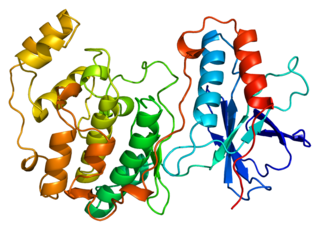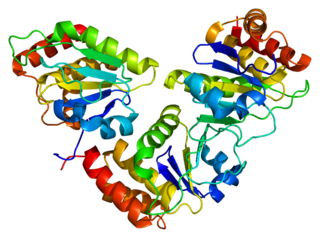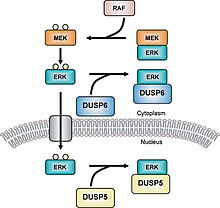A mitogen-activated protein kinase is a type of protein kinase that is specific to the amino acids serine and threonine. MAPKs are involved in directing cellular responses to a diverse array of stimuli, such as mitogens, osmotic stress, heat shock and proinflammatory cytokines. They regulate cell functions including proliferation, gene expression, differentiation, mitosis, cell survival, and apoptosis.
In molecular biology, extracellular signal-regulated kinases (ERKs) or classical MAP kinases are widely expressed protein kinase intracellular signalling molecules that are involved in functions including the regulation of meiosis, mitosis, and postmitotic functions in differentiated cells. Many different stimuli, including growth factors, cytokines, virus infection, ligands for heterotrimeric G protein-coupled receptors, transforming agents, and carcinogens, activate the ERK pathway.

Mitogen-activated protein kinase 1, also known as ERK2, is an enzyme that in humans is encoded by the MAPK1 gene.

Mitogen-activated protein kinase 14, also called p38-α, is an enzyme that in humans is encoded by the MAPK14 gene.

Mitogen-activated protein kinase 3, also known as p44MAPK and ERK1, is an enzyme that in humans is encoded by the MAPK3 gene.

Mitogen-activated protein kinase 8 is a ubiquitous enzyme that in humans is encoded by the MAPK8 gene.

Dual specificity protein phosphatase 1 is an enzyme that in humans is encoded by the DUSP1 gene.

Dual specificity mitogen-activated protein kinase kinase 6 also known as MAP kinase kinase 6 or MAPK/ERK kinase 6 is an enzyme that in humans is encoded by the MAP2K6 gene, on chromosome 17.

Dual specificity mitogen-activated protein kinase kinase 7, also known as MAP kinase kinase 7 or MKK7, is an enzyme that in humans is encoded by the MAP2K7 gene. This protein is a member of the mitogen-activated protein kinase kinase family. The MKK7 protein exists as six different isoforms with three possible N-termini and two possible C-termini.

Dual specificity phosphatase 6 (DUSP6) is an enzyme that in humans is encoded by the DUSP6 gene.

Dual specificity protein phosphatase 3 is an enzyme that in humans is encoded by the DUSP3 gene.

Dual specificity protein phosphatase 4 is an enzyme that in humans is encoded by the DUSP4 gene.

Dual specificity protein phosphatase 10 is an enzyme that in humans is encoded by the DUSP10 gene.

Dual specificity protein phosphatase 2 is an enzyme that in humans is encoded by the DUSP2 gene.

Dual specificity protein phosphatase 7 is an enzyme that in humans is encoded by the DUSP7 gene.

Dual specificity protein phosphatase 16 is an enzyme that in humans is encoded by the DUSP16 gene.

Dual specificity protein phosphatase 5 is an enzyme that in humans is encoded by the DUSP5 gene.

Mitogen-activated protein kinase 11 is an enzyme that in humans is encoded by the MAPK11 gene.
Dual-specificity phosphatase is a form of phosphatase that can act upon tyrosine or serine/threonine residues.
Candidalysin is a cytolytic 31-amino acid α-helical amphipathic peptide toxin secreted by the opportunistic pathogen Candida albicans. This toxin is a fungal example of a classical virulence factor. Hyphal morphogenesis in C. albicans is associated with damage to host epithelial cells; during this process Candidalysin is released and intercalates in host membranes. Candidalysin promotes damage of oral epithelial cells and induces lactate dehydrogenase release and calcium ion influx. It is unique in the fact that it is the first peptide toxin to be identified in any human fungal pathogen.

















